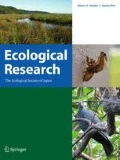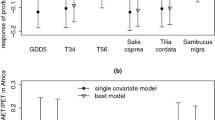Abstract
Observations made largely from summer breeding sites in Europe and North America have been used to document the effects of climate change on many bird species. We extend these studies by examining 23 years of observations between 1986 and 2008 of six winter bird species made by citizens at a city park in Yokohama, Japan. Bird species arrive in autumn and spend the winter in the area, before departing in the late winter or spring. On average, birds species are arriving 9 days later than in the past and are departing on average 21 days earlier, meaning that the average duration of their stay in Yokohama is about 1 month shorter now than in the past. Patterns of changes over time varied among species, but departure dates changed for more species than did arrival dates. Dates of departure and arrival were sometimes correlated with monthly average temperatures—later arrivals and earlier departures were associated with warmer temperatures. In addition, interannual variation in arrival and departure dates were strongly correlated across species, suggesting that species were responding to the same or similar environmental cues. This study provides a clear demonstration of the value of using citizens to make observations that contribute to research in climate change biology.


Similar content being viewed by others
References
Ahas R (1999) Long-term phyto-, ornitho- and icthyophenological time-series analyses in Estonia. Int J Biometeorol 42:119–123
Beaumont LJ, McAllan IAW, Hughes L (2006) A matter of timing: changes in the first date of arrival and last date of departure of Australian migratory birds. Glob Change Biol 12:1339–1354
Bergmann F (1998) Die Wegzugphänologie von Kleinvögeln in Mitteleuropa—Zugzeiten, Zugmuster, Abhängigkeit von der Witterung und langfristige Trends im Zeitpunkt des Durchzugs. PhD thesis, University of Constance
Berthold P (1991) Patterns of avian migration in light of current global ‘greenhouse’ effects: a Central European perspective. Acta Congr Int Ornithol 20:780–786
Bezzel E, Jetz W (1995) Verschiebung der Wegzugperiode bei der Mönchsgrasmücke (Sylvia atricapilla) 1966–1993—Reaktion auf die Klimaerwärmung? J Ornithol 136:83–87
Brazil M (2009) Birds of East Asia. Princeton University Press, NJ
Butler CJ (2003) The disproportionate effect of global warming on the arrival dates of short-distance migratory birds in North America. Ibis 145:484–495
Charmantier A, McCleery RH, Cole LR, Perrins C, Kruuk LEB, Sheldon BC (2008) Adaptive phenotypic plasticity in response to climate change in a wild bird population. Science 320(5877):800–803
Coppack T, Both C (2003) Predicting life-cycle adaptation of migratory birds to global climate change. Ardea 90:369–378
Cotton PA (2003) Avian migration phenology and global climate change. Proc Natl Acad Sci USA 100:12219–12222
Gatter W (1992) Zugzeiten und Zugmuster im Herbst: Einfluss des Treibhauseffekts auf den Vogelzug? J Ornithol 133:427–436
Gordo O, Sanz JJ (2005) Phenology and climate change: a long-term study in a Mediterranean locality. Oecologia 146:484–495
Gordo O, Brotons L, Ferrer X, Comas P (2005) Do changes in climate patterns in wintering areas affect the timing of the spring arrival of trans-Sahara migrant birds? Glob Change Biol 11:12–21
Huin N, Sparks TH (1998) Arrival and progression of the swallow Hirundo rustica through Britain. Bird Study 45:361–370
Huin N, Sparks TH (2000) Spring arrival patterns of the Cuckoo Cuculus canorus, Nightingale Luscinia megarhynchos, and Spotted Flycatcher Muscicapa striata in Britain. Bird Study 47:22–31
Hüppop O, Hüppop K (2003) North Atlantic Oscillation and timing of spring migration in birds. Proc R Soc B Biol Sci 270:233–240
Inouye DW, Barr B, Armitage KB, Inouye BD (2000) Climate change is affecting altitudinal migrants and hibernating species. Proc Natl Acad Sci USA 97:1630–1633
Iozawa H, Yoshino T, Yamagata N (2004) Birds of Japan, 550 birds in countryside; enlarged and revised edition. Bun-Ichi Co. Ltd., Tokyo (in Japanese)
IPCC (2007) Climate change 2007: impacts, adaptation and vulnerability. Contribution of Working Group II to the Fourth Assessment Report of the Intergovernmental Panel on Climate Change. Cambridge University Press, London
Jacobs JD, Wingfield JC (2000) Endocrine control of life-cycle stages: a constraint on response to the environment? Condor 102:35–51
Jenkins D, Watson A (2000) Dates of first arrival and song of birds during 1974–99 in mid-Deeside, Scotland. Bird Study 47:249–251
Jenni L, Kéry M (2003) Timing of autumn bird migration under climate change: advances in long-distance migrants, delays in short-distance migrants. Proc R Soc B Biol Sci 270:1467–1471
Jonzén N, Ergon T, Lindén A, Stenseth NC (2007) Bird migration and climate: the general picture and beyond. Clim Res 35:177–180
Kobori H (2009) Current trends in conservation education in Japan. Biol Conserv 142:1950–1957
Lehikoinen A, Sparks TH, Zalakevicius M (2004) Arrival and departure dates. In: Møller AP, Fiedler W, Berthold P (eds) Birds and climate change. Elsevier, Amsterdam, pp 1–31
Loxton RG, Sparks TH (1999) Arrival of spring migrants at Portland, Skokholm, Bardsey and Calf of Man. Bardsey Obs Rep 42:105–143
Loxton RG, Sparks TH, Newnham JA (1998) Spring arrival dates of migrants in Sussex and Leicestershire (1966–1996). Sussex Bird Rep 50:181–196
MacMynowski DP, Root TL (2007) Climate and the complexity of migratory phenology: sexes, migratory distance, and arrival distributions. Int J Biometeorol 51:361–373
Mason CF (1995) Long-term trends in the arrival dates of spring migrants. Bird Study 42:182–189
Menzel A, Sparks TH, Estrella N, Koch E, Aasa A, Ahas R, Alm-Kübler K, Bissolli P, Braslavská O, Briede A, Chmielewski FM, Crepinsek Z, Curnel Y, Dahl A, Defila C, Donnelly A, Filella Y, Jatczak K, Måge F, Mestre A, Nordli O, Peñuelas J, Pirinen P, Remišová V, Scheifinger H, Striz M, Susnik A, Van Vliet AJH, Wielgolaski F, Zach S, Zust ANA (2006) European phenological response to climate change matches the warming pattern. Glob Change Biol 12:1969–1976
Miller-Rushing AJ, Lloyd-Evans TL, Primack RB, Satzinger P (2008a) Bird migration times, climate change, and changing population sizes. Glob Change Biol 14:1959–1972
Miller-Rushing AJ, Primack RB, Stymeist R (2008b) Interpreting variation in bird migration times as observed by volunteers. Auk 125:565–573
Mills AM (2005) Changes in the timing of spring and autumn migration in North American migrant passerines during a period of global warming. Ibis 147:259–269
Moritz D (1993) Long-term monitoring of Palaearctic-African migrants at Helgoland/German bight, North Sea. Proc Pan-Afr Ornithol Congr 8:579–586
Parmesan C (2006) Ecological and evolutionary responses to recent climate change. Annu Rev Ecol Evol Syst 37:637–669
Parmesan C (2007) Influences of species, latitudes and methodologies on estimates of phenological response to global warming. Glob Change Biol 13:1860–1872
Parmesan C, Yohe G (2003) A globally coherent fingerprint of climate change impacts across natural systems. Nature 421:37–42
Primack RB, Ibáñez I, Higuchi H, Lee SD, Miller-Rushing AJ, Wilson A, Silander JA Jr (2009) Spatial and interspecific variability in phenological responses to warming temperatures. Biol Conserv 142:2569–2577
Pulido F, Berthold P, Mohr G, Querner U (2001) Heritability of the timing of autumn migration in a natural bird population. Proc R Soc B Biol Sci 268:953–959
Root TJ, Price JT, Hall KR, Schneider SH, Rosenzweig C, Pounds JA (2003) Fingerprints of global warming on wild animals and plants. Nature 421:57–60
Seki S (1998) Territorial behavior of the Pale Thrush (Turdus pallidus) wintering in the temperate evergreen broad-leaved forest. Trans Jpn For Soc 109:393–394 (in Japanese)
Sokolov LV, Markovets MY, Shapoval AP, Morozov Y (1998) Long-term trends in the timing of spring migration of passerines on the Courish Spit of the Baltic Sea. Avian Ecol Behav 1:1–21
Sparks TH, Braslavská O (2001) The effects of temperature, altitude and latitude on the arrival and departure of the swallow Hirundo rustica in the Slovak Republic. Int J Biometeorol 45:212–216
Sparks TH, Mason CF (2001) Dates of arrivals and departures of spring migrants taken from Essex bird reports 1950–1998. Essex Bird Rep 1999:154–164
Sparks TH, Mason CF (2004) Can we detect change in the phenology of winter migrant birds in the UK? Ibis 146(Suppl 1):57–60
Sparks TH, Menzel A (2002) Observed changes in seasons: an overview. Int J Climatol 22:1715–1725
Sparks TH, Roberts DR, Crick HQP (2001) What is the value of first arrival dates of spring migrants in phenology? Avian Ecol Behav 7:75–85
Sparks TH, Bairlein F, Bojarinova JG, Hüppop O, Lehikoinen EA, Rainio K, Sokolov LV, Walker D (2005) Examining the total arrival distribution of migratory birds. Glob Change Biol 11:22–30
Sparks TH, Huber K, Bland RL, Crick HQP, Croxton PJ, Flood J, Loxton RJ, Mason CF, Newnham JA, Tryjanowski P (2007) How consistent are trends in arrival (and departure) dates of migrant birds in the UK? J Ornithol 148:503–511
Strode PK (2003) Implications of climate change for North American wood warblers (Parulidae). Glob Change Biol 9:1137–1144
Studds C, Marra P (2007) Linking fluctuations in rainfall to nonbreeding season performance in a long-distance migratory bird, Setophaga ruticilla. Clim Res 35:115–122
Takeshita N, Kurechi M (2007) Chapter 20: what will happen to the birds? In: Domoto A, Iwatsuki K, Kawamichi T, McNeely J (eds) A threat to life—the impact of climate change on Japan’s biodiversity. Tsukiji-Shokan Publishing, Tokyo, pp 127–135
Tryjanowski P, Sparks TH (2001) Is the detection of the first arrival date of migrating birds influenced by population size? A case study of the red-backed shrike Lanius collurio. Int J Biometeorol 45:217–219
Tryjanowski P, Kuzniak S, Sparks TH (2002) Earlier arrival of some farmland migrants in western Poland. Ibis 144:62–68
Tryjanowski P, Kuzniak S, Sparks TH (2005) What affects the magnitude of change in first arrival dates of migrant birds? J Ornithol 146:200–205
Visser ME, Both C (2005) Shifts in phenology due to global climate change: the need for a yardstick. Proc R Soc B Biol Sci 272:2561–2569
Vogel C, Moritz D (1995) Langjährige Änderungen von Zugzeiten auf Helgoland. J ber Inst Vogelforsch 2:8–9
Walther GR, Post E, Convey P, Menzel A, Parmesan C, Beebee TC, Fromentin JM, Hoegh-Guldberg O, Bairlein F (2002) Ecological response to recent climate change. Nature 416:389–395
Wild Bird Society of Japan, Kanagawa-Branch (2007) Birds in Kanagawa Prefecture 2001–05: birds catalog V in Kanagawa prefecture with data appendix CD-ROM. Wild Bird Society of Japan Kanagawa-Branch, Yokohama (in Japanese)
Acknowledgments
We are grateful to all those whose observations contributed to the data reported at the Nature Observatory Forest in Yokohama. We extend our sincere thanks to Abraham Miller-Rushing, and Libby Ellwood for their constructive comments on previous drafts of the manuscript. The analyses reported in this paper were made possible by a grant from the Japanese Ministry of Education, Culture, Sports, Science and Technology to Hiromi Kobori.
Author information
Authors and Affiliations
Corresponding author
About this article
Cite this article
Kobori, H., Kamamoto, T., Nomura, H. et al. The effects of climate change on the phenology of winter birds in Yokohama, Japan. Ecol Res 27, 173–180 (2012). https://doi.org/10.1007/s11284-011-0891-7
Received:
Accepted:
Published:
Issue Date:
DOI: https://doi.org/10.1007/s11284-011-0891-7




